Arm Announces Neoverse V1, N2 Platforms & CPUs, CMN-700 Mesh: More Performance, More Cores, More Flexibility
by Andrei Frumusanu on April 27, 2021 9:00 AM EST- Posted in
- CPUs
- Arm
- Servers
- Infrastructure
- Neoverse N1
- Neoverse V1
- Neoverse N2
- CMN-700
PPA & ISO Performance Projections
We’ve noted about the microarchitectural changes in the new V1 and N2 processors, as well as their IPC improvements, but it’s important to actually put things into context of the actual performance and power requirements to reach those figures. Arm presented an ISO-process node figures of what we can expect out of the designs:
Starting off, we’re presented with a refresher of where exactly the Neoverse N1 was projected to end up. Back in 2019, the company had noted that an N1 core with 1MB L2 would take roughly 1.4mm² of area, and use up to 1.8W at 3.1GHz (TSMC 7nm node projection).
We’ve generally seen more conservative implementations (Graviton2) and more aggressive implementations (Altra Q) of the N1, but Arm states that their original presilicon projections ended up within 10% of the actual silicon performance figures of the respective products.
Compared to an N1, the V1 is meant to achieve 50% higher IPC, or 1.5x its predecessor while maintaining the same frequency capabilities.
What’s important to note on the slide here is that Arm is stating that power efficiency ranges from 0.7x to 1x that of the N1. Reversing the calculation for power usage increases, we actually end up with a 1.5x to 2.14x increase, which is actually quite significant. Arm also notes that the core is 1.7x larger than the N1, which is also a significant figure.
SiPearl’s Rhea chip was the first publicly known Neoverse V1 design and it features 72 cores on a N6 process node. The V1 core’s vastly increased power consumption means that it’s going to be incredibly hard to achieve similar clock frequencies while remaining in the similar 250W TDP range such as that of a current-gen top-end 80-core Altra chip, so either the core will have higher TDPs, or running at lower frequencies.
Arm also projects further non-ISO process performance figures which we’ll cover just a bit later, but there the company showcases a reference design of the V1 with 96 cores on 5nm at 2.7GHz. This means that whilst the microarchitecture seemingly would have the same frequency capabilities, the much higher power consumption of the core puts a practical limit onto the maximum frequency of any such larger core count designs.
The Neoverse N2 seems a more appropriate design. Only losing out 10% IPC versus the V1, its power consumption is targeted to be only 1.45x higher than that of an N1, meaning efficiency lands in at an almost equal 96%. The area usage here is also only 1.3x that of an N1.
So generally speaking, the N2 seems to be a linear increase in performance over the N1 – both in performance and power. While this is not a regression in efficiency (well a small one at least), it does actually mean that in terms of frequency and end-performance targets, new N2 designs require larger generational process node improvements for actual vendors to be able to actually achieve the larger IPC and performance improvements that the new microarchitectures are promising.
I take note again of situations and workloads on the Ampere Altra where we’ve seen that there’s lots of workloads where the chip operates at below the TDP because the CPUs are underutilised. If an N2 design would be able to raise performance in such workloads, and more heavily throttle itself in higher demanding high utilisation workloads, it would still mean a net positive performance benefit even regardless of process node progresses. It’s a balance and situation that will be interesting to see how it plays out in eventual Neoverse N2 products.
In terms of absolute IPC improvements, Arm also disclosed a more varied set of workloads and what to expect out of the V1 and N2.
For the V1, the IPC improvements are roughly 50% median, with SPEC CPU essentially ending up at this figure. Arm made emphasis that there’s a set of workloads that are able to take advantage of SVE and the increased vector execution width of the V1 microarchitecture to achieve IPC improvements in excess of 100-125%, which is quite impressive.
The N2’s median IPC increase lands at a median of 32%, with SPEC CPU at roughly those marketed 40% figure. The high-end isn’t as high as that of the V1, but still in excess of +50% IPC.
Finally, Arm also posted estimated figures for the components of SPEC CPU 2017, where we see the generational improvements be relatively even across the workloads, with a few exceptions where the V1’s larger characteristics come into play. There’s also workloads such as 541.leela_r where the N2 actually leads the V1, and Arm explained this by the fact that the N2 is actually a newer microarchitecture with further front-end improvements that aren’t found on the V1.


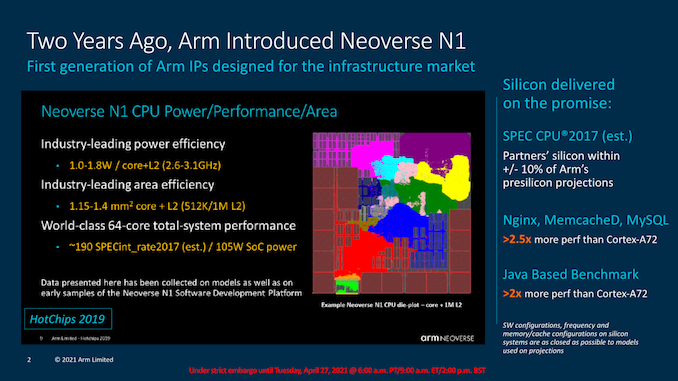
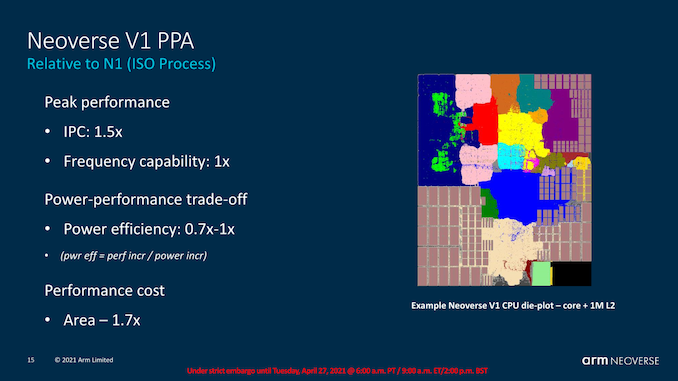
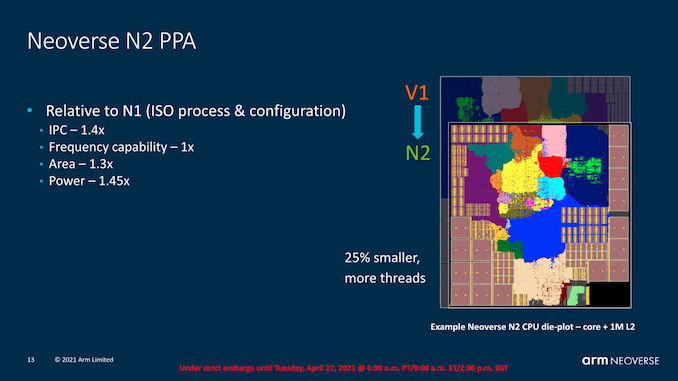
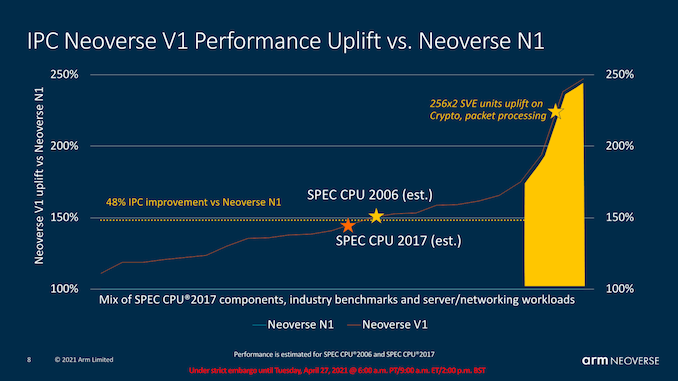
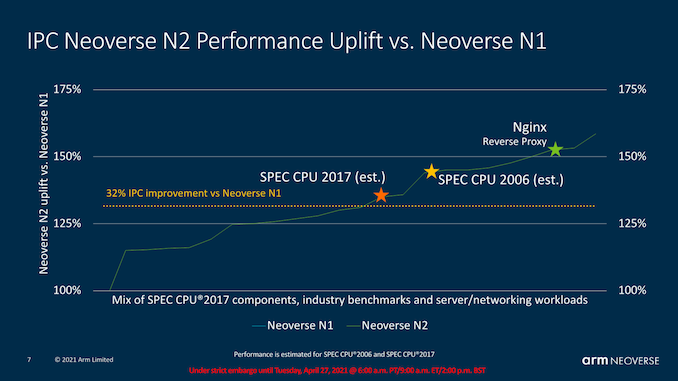
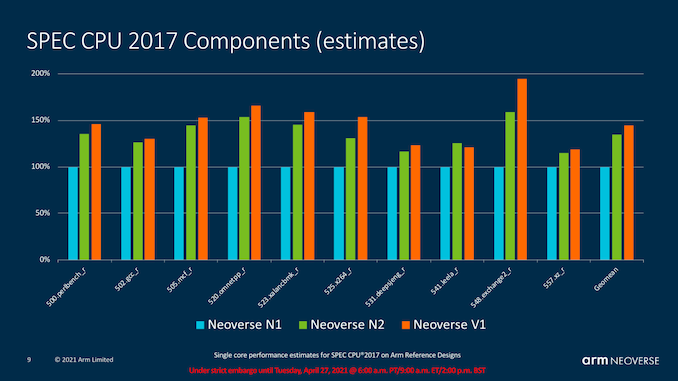








95 Comments
View All Comments
Oxford Guy - Tuesday, April 27, 2021 - link
‘Fast-forward to 2021, the Neoverse N1 design today employed in designs such as the Ampere Altra is still competitive, or beating the newest generation AMD or Intel designs – a situation that which a few years ago seemed anything but farfetched.’Hmm... That last bit is odd. Either it’s just ‘farfetched’ or it’s ‘expected’.
eastcoast_pete - Tuesday, April 27, 2021 - link
Yes, those slides look very promising; now eagerly awaiting an eventual test of one or two of these in a actual silicone. I guess then we'll see how they measure up.mode_13h - Tuesday, April 27, 2021 - link
Silicone - From Wikipedia, the free encyclopediaNot to be confused with the chemical element silicon.
A silicone or polysiloxane is a polymer made up of siloxane (−R2Si−O−SiR2−, where R = organic group). They are typically colorless, oils or rubber-like substances. Silicones are used in sealants, adhesives, lubricants, medicine, cooking utensils, and thermal and electrical insulation.
eastcoast_pete - Thursday, April 29, 2021 - link
I'll have to take this up with auto-correct. It keeps changing silicon to silicone. Now that I forced it again to leave silicon alone (for the umpteenth time), maybe it will stop (:Mondozai - Tuesday, April 27, 2021 - link
Fantastic overview by Andrew. AT's most underrated reporter. Hopefully he gets more responsibility to cover more things in the future.Linustechtips12#6900xt - Tuesday, April 27, 2021 - link
AGREEDdotjaz - Tuesday, April 27, 2021 - link
Good, finally confirmed N2 is in fact ARMv9 as suspected. Now we'll just have to wait and see how the new mobile counterparts are. Hopefully we'll see some real improvements.It'll be interesting to see how small the new low power v9 core is given that it has to have a 128b SVE2 pipeline instead of 2x64b NEON.
mode_13h - Wednesday, April 28, 2021 - link
> finally confirmed N2 is in fact ARMv9 as suspected.> Now we'll just have to wait and see how the new mobile counterparts are.
> Hopefully we'll see some real improvements.
The data presented on N2 doesn't give me much hope that v9 changed much, besides the feature baseline. I was hoping for something slightly revolutionary, but it's certainly not that.
dotjaz - Thursday, April 29, 2021 - link
> hoping for something slightly revolutionaryWe've known for a couple of years ARMv9 is just ARMv8.x rebased. Your hopes weren't realistic to begin with. Besides, what "revolutionary" features would you expect ISAs to include? Can oyu name one? ARMv8.5a+SVE2 already has everything you need to design an excellent and efficient uarch. Why re-invent the wheel just for the sake of it?
mode_13h - Thursday, April 29, 2021 - link
> We've known for a couple of years ARMv9 is just ARMv8.x rebased.You knew this according to where? It's one thing to assume that, and clearly it wasn't an unreasonable assumption, but it's another thing to *know* it. So, how did you *know* it?
> Besides, what "revolutionary" features would you expect ISAs to include? Can oyu name one?
It's a fair question. Generally speaking, anything that would help improve efficiency. Maybe things like scheduling hints or maybe some kind of tags to indicate memory writes that are thread-private and terminal reads. Just some examples, off the top of my head.
> ARMv8.5a+SVE2 already has everything you need to design an excellent and efficient uarch.
The issue I see is that IPC and efficiency gains are going to become ever more hard-won, so there needs to be some more creativity in redefining the SW/HW interface to unlock further gains. ARMv9 is going to be with us for probably another decade and it could end up having to compete with yet-to-be-identified alternatives like maybe RISC VI or something completely out of left-field. So, I see it as a wasted opportunity. A pragmatic decision, for sure, but a little disappointing.